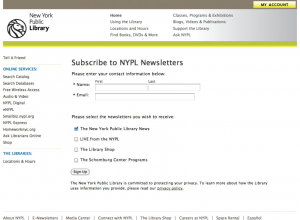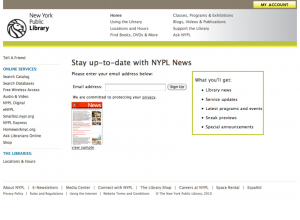Maximizing Email List Growth: How the New York Public Library drove a 52.8% lift in newsletter subscriptions
At the end of this month, a who’s who of email marketers will descend on Caesar’s Palace in Las Vegas for MarketingSherpa Email Summit 2011. Flint McGlaughlin, the Managing Director (CEO) of MECLABS will teach a two-hour email optimization training session and your peers will be presenting 21 email marketing case studies.

One such case study that I thought would be of particular interest to readers of the MarketingExperiments blog is entitled, “Leveraging Transactional Messages to Boost Email Newsletter Opt-Ins,” and will be presented by Johannes Neuer, eCommunications Manager, The New York Public Library.
If you are attending the Email Summit, Johannes will be presenting in Breakout Session #1 on Wednesday (Day 3), just before the networking lunch and sponsor exposition. His full case study has about as much helpful information and educational data as you’ll find on a trip between the lions. Here is a quick look at what Johannes will be speaking about…
First off, why is The New York Public Library using email? How is it similar to and different from traditional email marketers?
Johannes Neuer: The New York Public Library is using email as an effective way to stay in touch with a growing number of patrons and supporters. Similar to traditional email marketers, we have a suite of corporate eCommunications vehicles, which include NYPL News, our monthly newsletter, NYPL Programs, featuring events and programs for adults, and NYPL Family Programs, which provides content and event listings for families with children.
What’s different is that all of our services are free. Therefore, our newsletters are mainly focused on marketing Library content and services aiming at driving traffic to our website and increasing engagement with NYPL through the use of our collections and through physical visits to our 91 locations. In addition to that, our Development Department is using email for fundraising.
You’re passionate about email list growth. Why? What is the value of a large email list in an age of ascendant social media?
JN: When patrons subscribe, there is a value exchange. They give NYPL their email address and we provide content that they requested – thus allowing us access to their much coveted inbox.
This kind of relationship requires more trust than hitting the “Like” button on Facebook. We have noticed that this trust relationship that we nurture over time pays off when the Library needs to rally support.
While we were very successful in using social media and video creatively to get the word out during NYPL’s advocacy campaign last summer (the campaign was inducted into MarketingSherpa’s 2010 Viral and Social Marketing Hall of Fame), our large list of email subscribers has shown much greater engagement than the social media channels in terms of completed online actions, such as writing letters to legislator or making donations.
That’s why we are still focusing on continuing to grow our email list.
One thing I like about your case study is that, to maximize list growth, you conducted landing page optimization through A/B testing. Expecting an increase in traffic, you ran an A/B split test using Google Website Optimizer to optimize the opt-in.
What lessons did you learn from that testing that your fellow marketing VPs and directors can use on their own sites?
JN: The biggest lesson we learned from this test is that you need a lot of traffic to get meaningful results in a short period of time, and that you need to be willing to make radical changes to the landing page. The test mentioned in the case study was actually the second one that we conducted because the first one did not yield a clear winner.
The combination of more substantial changes to the landing page and the addition of transactional messages as a new source of traffic helped identify the optimized form – with a 52.8% lift in NYPL newsletter subscriptions – as the winner.
In this case, a good opt-in form consisted of just the email field and the submit button, which are supported by a benefit-oriented headline, a list of things subscribers can expect from the newsletter, and a sample newsletter preview. We continue to use this form on dedicated NYPL newsletter sign-up pages.
Your conversion rate actually went down, but that didn’t bother you. Why not?
JN: When doing any kind of testing it is important to focus on the outcome – the goal of the exercise. Our key performance indicator was the absolute number of subscribers gained during a given month.
By adding a new traffic source and optimizing the form, NYPL doubled the number of opt-ins but our conversion rate went down by a little less than one percentage point. We were pretty content with this outcome, which doesn’t mean one can’t still try to nudge the needle on the conversion rate through further experiments.
One of the key ways you say to make transaction messages work is to test promotional copy and landing page combinations for each channel. What have you learned from testing by channel, as opposed to testing the audience you are trying to convert to email subscriptions as one giant group?
JN: Testing by channel allows us to tailor the promotional copy in messaging and on the landing page for best results. We have set up dedicated sign-up pages with different copy for all NYPL newsletters because the expectations of patrons coming from a sign-up link that promotes our family newsletter are going to be different than the ones looking for the general newsletter.
During the last month, the conversion rate on the dedicated forms separated by channel is over 9% higher than the conversion rate on the catch-all sign-up form that lists all newsletter options.
Related resources
Email Optimization: How to improve ROI from capture to conversion
Free MarketingSherpa Email Marketing Newsletter – Case studies and How To articles





